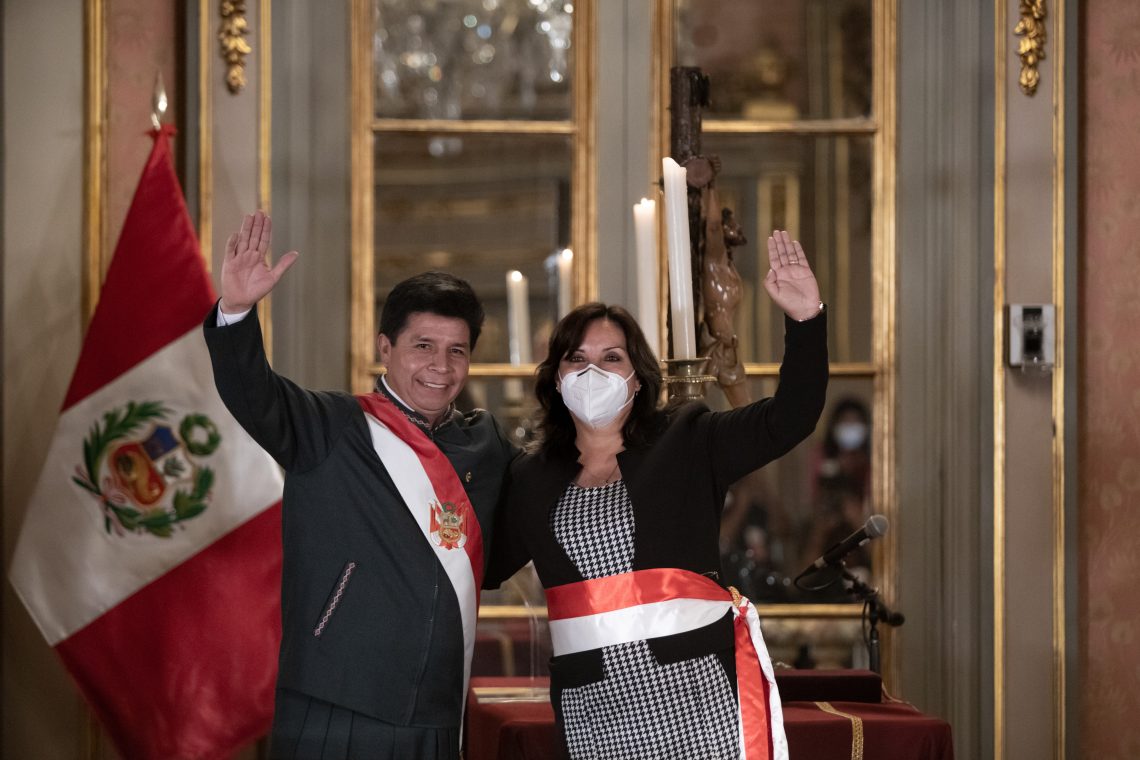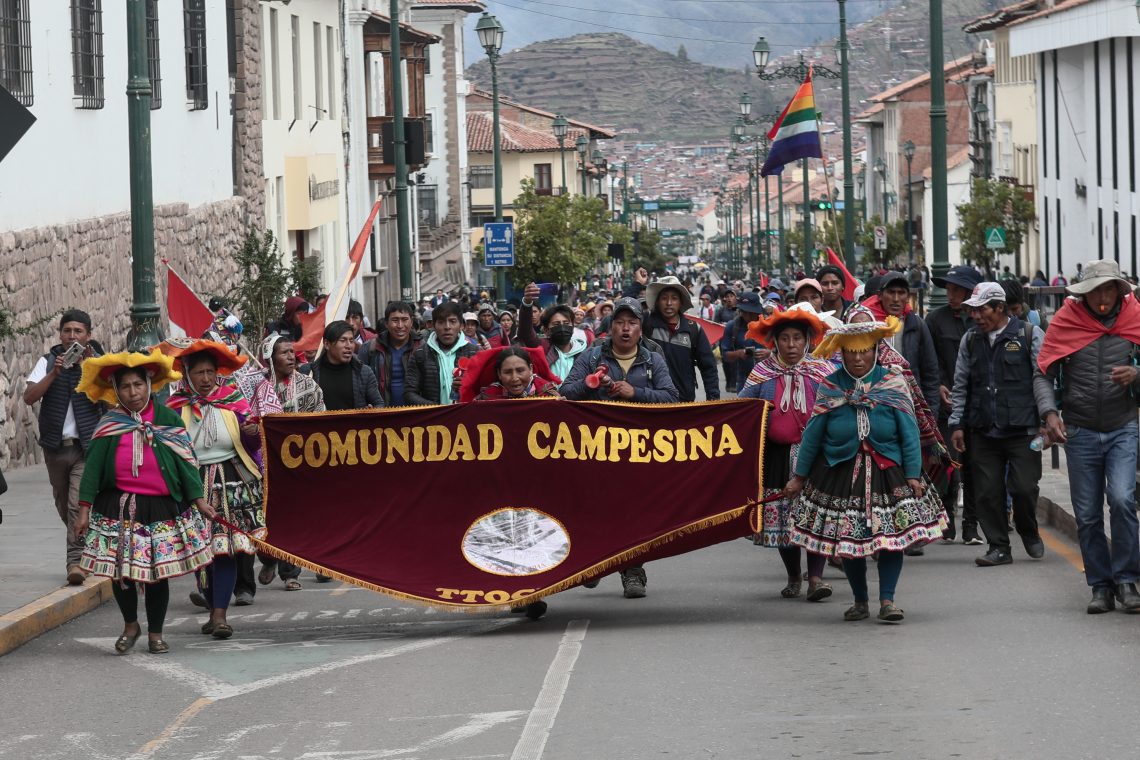Peru’s cycle of instability continues
Peru’s presidents come and go in rapid succession amid extreme public distrust. The fast-growing country’s democracy needs a hard reset, but that will take time.

In a nutshell
- The new president of Peru already faces strong opposition
- Stabilizing the crisis-ridden country will take more than another election
- A new constitutional order is what the country needs to preserve democracy
On December 7, 2022, just hours before he was due to face a third impeachment vote, Peruvian President Pedro Castillo announced that he would close Congress and form an emergency government until new legislative elections could be held. Lawmakers widely condemned these actions as an autogolpe (self-coup) and proceeded with the impeachment vote, approving his removal from office by a wide margin after just a bit longer than 16 months in power.
Following President Castillo’s impeachment, First Vice President Dina Boluarte assumed power via constitutional succession as the country’s first woman president – and its sixth chief executive since 2018. Yet her political survival is not guaranteed. Nationwide protests have rocked the country since the left-wing Castillo’s ouster, with many demonstrators demanding Ms. Boluarte’s resignation. A heavy-handed response by state security forces has resulted in dozens of deaths and thousands of injuries, fanning the flame of opposition.
Facts & figures
Peru factbox
Peru is the world’s second-largest producer of copper and, for years, one of Latin America’s fastest-growing economies. Ancient Peru was the seat of several prominent Andean civilizations, notably that of the Incas whose empire the Spanish conquistadors captured in 1533. It declared its independence on July 28, 1821 (presently the Independence Day; the remaining Spanish forces were defeated in 1824).
Castillo’s missteps
President Castillo’s removal came as a surprise to few. Three of the four previous presidents – Pedro Pablo Kuczynski (2016-2018, in office for one year 238 days), Martin Vizcarra (2018-2020, in office for two years 231 days), and Manuel Merino (in office for five days in November 2020) – had been forced to step down before their terms ended. And as a November 29, 2021, GIS report noted, Mr. Castillo entered office with fragmented legislative support, a weak popular mandate and little political experience.
Upon taking office, President Castillo faced almost immediate threats of legislative removal from the intransigent opposition. In early December of 2021, legislators brought a formal motion of impeachment against him on the grounds of “moral incapacity.” However, the resolution fell six votes short of triggering a full trial. In March 2022, the president again faced the prospect of impeachment, with the process advancing to a full trial in Congress in which he would be required to respond to the array of charges against him. As before, he survived the floor vote. Yet this was only a short reprieve.
The former president’s last strategic miscalculation was the clumsy self-coup attempt.
Along the way, President Castillo made several costly missteps. He filled his cabinet, for instance, with fringe and inexperienced figures, some of whom flirted with political radicalism and others courted scandal. Moreover, extreme cabinet volatility hurt his government: with a total of 81 ministers across 19 cabinet portfolios during a 16 month-presidency, the average minister lasted only four months on the job. Most damaging to Mr. Castillo, however, were the corruption scandals tied to him, from accusations of backroom deals over public infrastructure projects to influence peddling in the military.
The former president’s last strategic miscalculation was the clumsy autogolpe attempt. Beyond its unconstitutionality, he lacked the political capital and support of the military that are generally necessary for such an authoritarian takeover to work – as it had for Alberto Fujimori in 1992. Mr. Castillo failed to read the signs. For example, a few days before the attempted institutional takeover, he was forced to replace Defense Minister Daniel Barragan after the latter allegedly refused to seek support from the military high command for shutting down Congress. Nor was there any indication that cabinet members or other institutional actors supported this gambit. Even more puzzling, it seems likely that President Castillo would have survived the impeachment vote, undermining his rationale for circumventing it.
Anger and unrest
Unfortunately for his successor, Ms. Boluarte, Mr. Castillo’s impeachment has been a catalyst for widespread popular mobilization that paralyzed transportation and commerce in the country and now threatens the survival of her government. These protests have united diverse groups in the population that do not necessarily share a common goal beyond the early holding of a general election.

President Boluarte is a capable lawmaker who has assumed the unenviable task of ushering the country through this crisis. Unfortunately, she must contend not only with day-to-day governance but the demands of short- and long-term crisis management without legislative allies, a political party or the benefit of the doubt from the fed-up Peruvians.
Compounding her problems, not all observers interpret President Castillo’s actions as illegal. Many of the ex-president’s rural supporters have denounced his ouster and preventative detention and are demanding his return. They are not alone: the left-leaning governments of Argentina, Bolivia, Colombia and Mexico released a joint statement expressing their “concern” over President Castillo’s removal, thus adding legitimacy to protesters’ grievances.
The state’s coercive security apparatus has killed over 50 protestors and injured thousands, inflaming popular anger rather than quelling it.
Peru’s identity politics play a role in the crisis. Many rural, indigenous Peruvians see President Castillo’s removal as one of their own being forced from office by a distant and disdainful Limeño elite – even if they did not support Mr. Castillo.
It is also clear that widespread anger is driven by structural and circumstantial problems, from long-standing inequalities and poor political representation to inflation and a rising cost of living. And then there are the effects of persistent droughts.
Lastly, security forces’ lethal crackdowns on demonstrators under President Boluarte have aggravated tensions. Since President Castillo’s impeachment, the state’s coercive security apparatus has killed over 50 protestors and injured thousands, inflaming popular anger rather than quelling it.
Surveys show that the public is united in its exasperation with the political establishment and standard-bearer institutions. In one national poll, more than 75 percent of survey respondents said they disapprove of Ms. Boluarte’s job as president and believe she should resign, while 89 percent said they disapprove of Congress. Only 24 percent could even name someone they would like to succeed Ms. Boluarte as president. Under these conditions, it is unclear if early elections or even a constituent assembly would mend the country.
Elections or new constitution
President Boluarte realizes that she is hardly in a position to effect deep reform. Like Mr. Castillo before her, she lacks a broad popular mandate, stable legislative support and institutional allies.
Recognizing that she leads a caretaker government, President Boluarte initially expressed support for a proposal to hold national elections in April 2024 rather than 2026, as previously scheduled. However, in the face of the ongoing unrest, she proposed moving them up even earlier, to October 2023. As of this writing, however, Peru’s Congress has soundly rejected this latest proposal, with lawmakers rightfully fearing for their reelection in the current political climate.
Governability will be difficult, and support for the next president fickle – as the Congress of the Republic will remain divided among 10 or so parties united around mutual interests.
An alternative to defuse protests and gain citizens’ trust is for the government to pursue constitutional reform against all risks, either directly or by setting the stage for the next Congress to do so – by naming a Constitutional Commission or through a Constituent Assembly. That could at least placate Castillo supporters and those on the political left.
Scenarios
Without fundamental changes to the political system and regardless of when elections are held, the long-term political dysfunction that has plagued Peru for nearly a decade will continue. The party system (or party non-system, as some academics call it) is atomized, and citizens have little confidence in their political leaders and institutions.
Boluarte survives, problems persist
The most likely scenario is that Ms. Boluarte manages to weather the present storm but accomplishes little else.
As in 2021, the presidential field for the next elections will almost certainly consist of 10 or more candidates polling in the single- or low double-digits and vying for a place in the runoff election – which could very well feature an unpopular right-wing Fujimorista candidate against an unpopular left-wing anti-Fujimorista one. Governability will be difficult, and support for the next president fickle – as the Congress of the Republic will remain divided among 10 or so parties united not around programmatic platforms but mutual interests.
Elections would then restart the poisonous cycle of executive-legislative bargaining that feature changing coalition partner demands and the inevitable defections, and then the increasingly desperate game of chicken whereby the president threatens to dissolve Congress while the legislature threatens to impeach the president. Meanwhile, political actors’ focus on their survival and minimal governability will do little to resolve the country’s underlying inequities, access to state services, or representation.
Ultimately, Peru’s politics and political system need a full reset, but under the current scenarios, it is unclear if there would be one on the horizon.
Boluarte launches constitutional changes
It cannot be excluded, though, that President Boluarte manages to placate critics by starting the process of reforming the country’s 1993 constitution. Such a move, aimed at those on the left who have called for a constituent assembly to draft a new Magna Carta, could also appeal to voters of other ideological stripes. In a January 15, 2023, survey by the Instituto de Estudios Peruanos (IEP), 69 percent of respondents supported the formation of a constituent assembly to change the constitution.
That could take several forms. So far, President Boluarte has said she would entrust a Constitutional Committee to the next Congress with the task. Doing so would diffuse some of the protestors’ grievances and help guarantee the president’s political survival. That, in turn, would allow her to focus on day-to-day governance matters, from economic policy to social welfare, rather than crisis management. It would also give the Peruvian electorate some much-needed (but nearly forgotten) sense of optimism.
Boluarte falls, chaos deepens
The worst-case scenario, fortunately not the most likely, is that Ms. Boluarte becomes another Peru president forced to quit before the elections.
That could happen if the unrest does not subside, anti-government demonstrations, violence and repression grow and ultimately, protestors converge on Lima demanding her resignation. To avoid further bloodshed and chaos, Ms. Boluarte gives up. Another possibility is that the president tries to force the issue of early elections with a recalcitrant legislature that retorts by impeaching her.
In either case, the change in government does nothing to improve governability or address voters’ cost of living concerns or underlying anger with the political system. It merely kicks the can of constitutional reform down the road. More instability also further damages the country’s economic prospects.
In this troubling scenario, authoritarian candidates promising “order and progress” would become even more appealing, further endangering Peru’s shaky democracy.
Facts & figures
Peru Factbox
- Government type: presidential republic.
- Capital: Lima.
- Constitution: several; the latest was enacted on December 31, 1993.
- Population: 32,275,736 (2022 est.)
- Labor force: 18.352 million (2021 est.)
- Ethnic groups: Mestizo (mixed American Indian and White) 60.2%, American Indian 25.8%, White 5.9%, African descent 3.6%, other (includes Chinese and Japanese descent) 1.2%, unspecified 3.3% (2017 est.)
- Population distribution: approximately one-third of the population resides along the coastal desert belt in the west, with a strong concentration in the capital city; the Andean highlands (sierra) are strongly identified with the country’s American Indian population. They contain roughly half of the overall population; the eastern slopes of the Andes, and adjoining rainforest, are sparsely populated.
- Natural resources: copper, silver, gold, petroleum, timber, fish, iron ore, coal, phosphate, potash, hydropower and natural gas.
- Real GDP (PPP, in 2017 U.S. dollars): $421.937 billion (2021 est.)
- Real GDP per capita: $12,500 (2021 est.)
- Real GDP growth rate: 13.35% (2021 est.)
- Military expenditure: 1.1% of GDP (2021 est.)
- Military and security personnel: information varies; approximately 95,000 active duty personnel (60,000 army; 25,000 navy, including about 4,000 naval infantry and 1,000 coast guard; 10,000 air force) (2022).
- Note: As of 2022, the Peruvian security forces continued operations against remnants of the Shining Path (Sendero Luminoso) terrorist group, particularly in eastern parts of the country.
Source: The World Factbook, CIA








